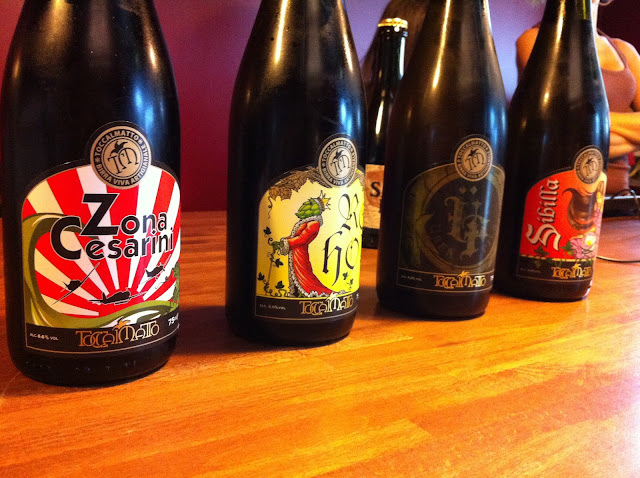Parmesan Formaggio, Prosciutto, and Toccalmatto Birra
I hope you gathered that I'm in Parma now. This is one of the richest veins of brewing, with Ducato, Panil, and the place I visited today, Toccalmatto. Founded by Bruno Carilli four years ago, it has risen to that top layer of high-profile breweries (and thus came to my attention).
The more I see of Italian brewing, the more I see of three clear points of reference: Belgium, the US, and Germany. Of these, Germany is the least, expressing itself mainly as familiar styles--weizen, Kolsch, pils, and helles. From the US and Belgium, brewers borrow method. Like Belgium, Italy is bottle-based; breweries bottle condition their beer in warm rooms. (In the US, even when they do bottle condition, breweries rarely treat the process as a second fermentation that adds depth and character to the beer as they do in Belgium. And Italy.) However, Italian breweries hop their beers like Americans, and I'm not just talking dosage. They like lots of late--addition hops and dry-hops. (Belgians also often use sugar, which thins the beer and makes hops harsher and more violent. The Italians don't use sugar.)
Which brings us to Carilli. His first two beers were an American-style pale (Re Hop, or hop king) and a saison Sibilla). These are his two main tracks, but they blend in process. There's a third, smaller influence--England. His system looks more English than American and he's made a bitter and mild to boot.
In a lot of ways, toccalmatto looks pretty American in the surface. Scanning his line would bring nods of recognition from Portlanders. But the beers don't taste American. He uses US hops, but relies more heavily on Australia and New Zealand. A lot of people equate the "new world" strains, but as someone intimately familiar with American strains, I am here to tell you that that's just wrong. In Oceana, another saison, he gets a distinctive bergamot flavor--more Asian than American. I also picked up a flavor I couldn't adequately explain in several of the beers--my inadequate description is mint--but definitely nothing that comes from US hops.
He's got a barrel-aging program and here too there are differences. No bourbon; instead, rum, Scotch whisky (Caol Ila), and of course Italian wine barrels. He's aged a barleywine in the whisky barrels (Stray Dog) and it is spectacular.
I could say a lot more about Bruno, but it's near the end of my trip (home Monday), and I'm running out of gas. How's this: great beer, not exactly like anything out there, and you have to come to Europe to drink it (for now).
The pics, with captions.
1. Bruno at a fermenter.
2. Ancient rum barrels.
3. The filter that often doubles as a hopback.
4. A few of the beers.
The more I see of Italian brewing, the more I see of three clear points of reference: Belgium, the US, and Germany. Of these, Germany is the least, expressing itself mainly as familiar styles--weizen, Kolsch, pils, and helles. From the US and Belgium, brewers borrow method. Like Belgium, Italy is bottle-based; breweries bottle condition their beer in warm rooms. (In the US, even when they do bottle condition, breweries rarely treat the process as a second fermentation that adds depth and character to the beer as they do in Belgium. And Italy.) However, Italian breweries hop their beers like Americans, and I'm not just talking dosage. They like lots of late--addition hops and dry-hops. (Belgians also often use sugar, which thins the beer and makes hops harsher and more violent. The Italians don't use sugar.)
Which brings us to Carilli. His first two beers were an American-style pale (Re Hop, or hop king) and a saison Sibilla). These are his two main tracks, but they blend in process. There's a third, smaller influence--England. His system looks more English than American and he's made a bitter and mild to boot.
In a lot of ways, toccalmatto looks pretty American in the surface. Scanning his line would bring nods of recognition from Portlanders. But the beers don't taste American. He uses US hops, but relies more heavily on Australia and New Zealand. A lot of people equate the "new world" strains, but as someone intimately familiar with American strains, I am here to tell you that that's just wrong. In Oceana, another saison, he gets a distinctive bergamot flavor--more Asian than American. I also picked up a flavor I couldn't adequately explain in several of the beers--my inadequate description is mint--but definitely nothing that comes from US hops.
He's got a barrel-aging program and here too there are differences. No bourbon; instead, rum, Scotch whisky (Caol Ila), and of course Italian wine barrels. He's aged a barleywine in the whisky barrels (Stray Dog) and it is spectacular.
I could say a lot more about Bruno, but it's near the end of my trip (home Monday), and I'm running out of gas. How's this: great beer, not exactly like anything out there, and you have to come to Europe to drink it (for now).
The pics, with captions.
1. Bruno at a fermenter.
2. Ancient rum barrels.
3. The filter that often doubles as a hopback.
4. A few of the beers.



